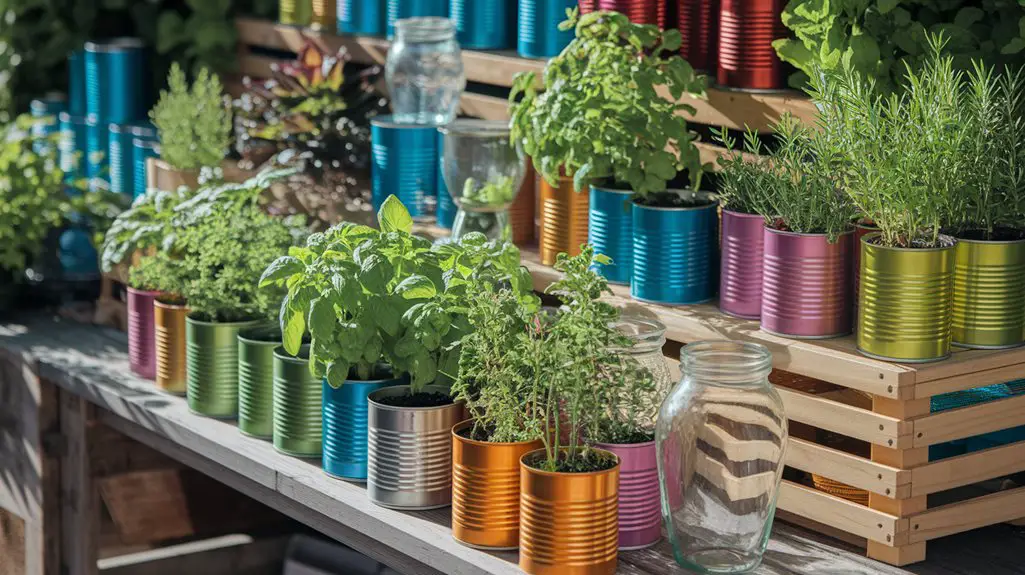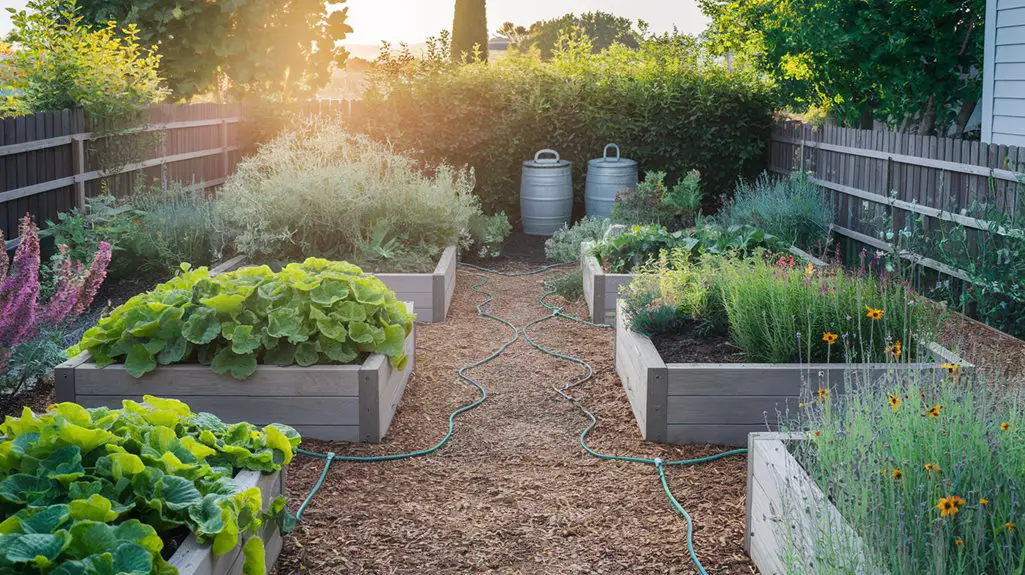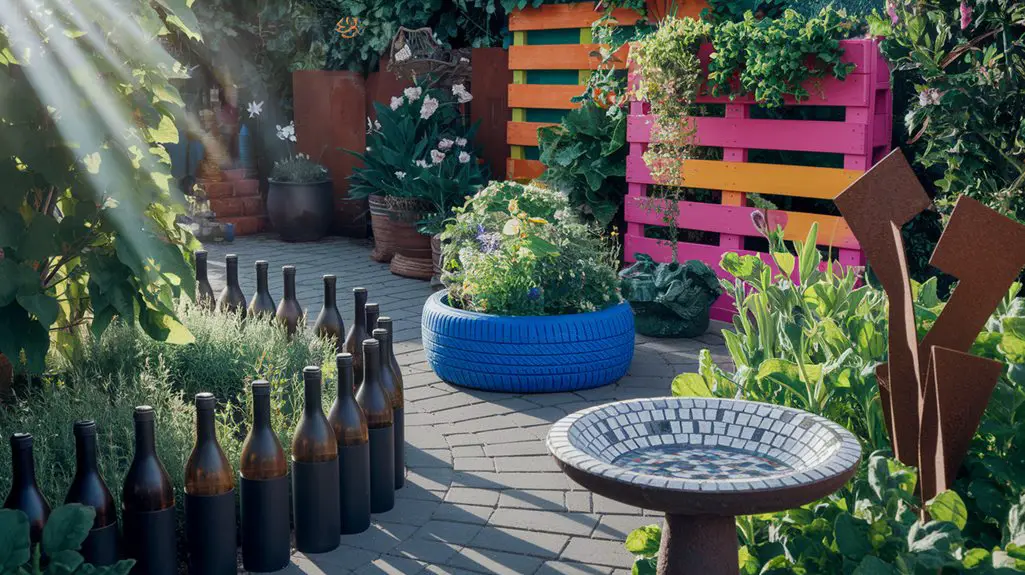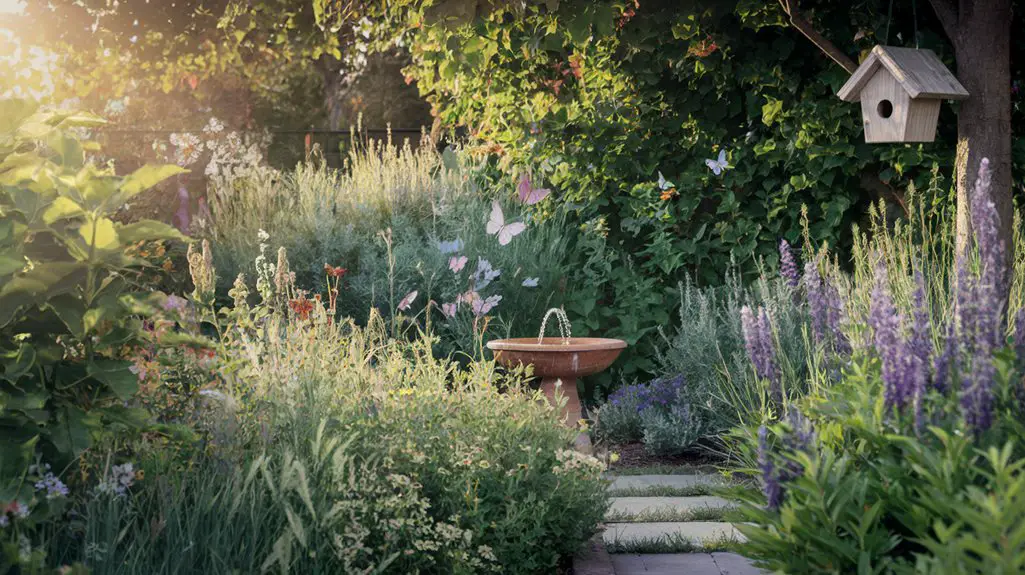Your herb garden doesn't need expensive planters or fancy equipment to thrive. Instead, look around your home for items headed to the recycling bin. Those empty tin cans, broken chairs, and unused gutters can transform into perfect growing spaces for your basil, mint, and thyme. You'll reduce waste, save money, and create a uniquely personal garden space. The sustainable solutions waiting in your garage or attic might surprise you—and your herbs won't know the difference.
Transforming Old Kitchen Containers Into Herb Planters
Before tossing out those old kitchen containers, consider giving them a second life as herb planters. Cracked mixing bowls, chipped teapots, and unused colanders make perfect vessels for growing herbs, reducing landfill waste while adding character to your garden.
For plastic containers, drill drainage holes in the bottom and fill with quality potting soil. Metal tins work well for moisture-loving herbs like mint, while ceramic bowls suit drought-tolerant rosemary and thyme. Old mason jars can house small herbs when layered with activated charcoal and pebbles for drainage. To create a thriving garden in limited space, consider small herb garden ideas that maximize your apartment's potential.
Label your repurposed planters with paint pens or attach wooden spoons as markers. Position containers based on each herb's sunlight needs, creating a sustainable kitchen garden that celebrates resourcefulness while providing fresh flavors for your cooking.
Vertical Herb Gardens From Repurposed Pallets
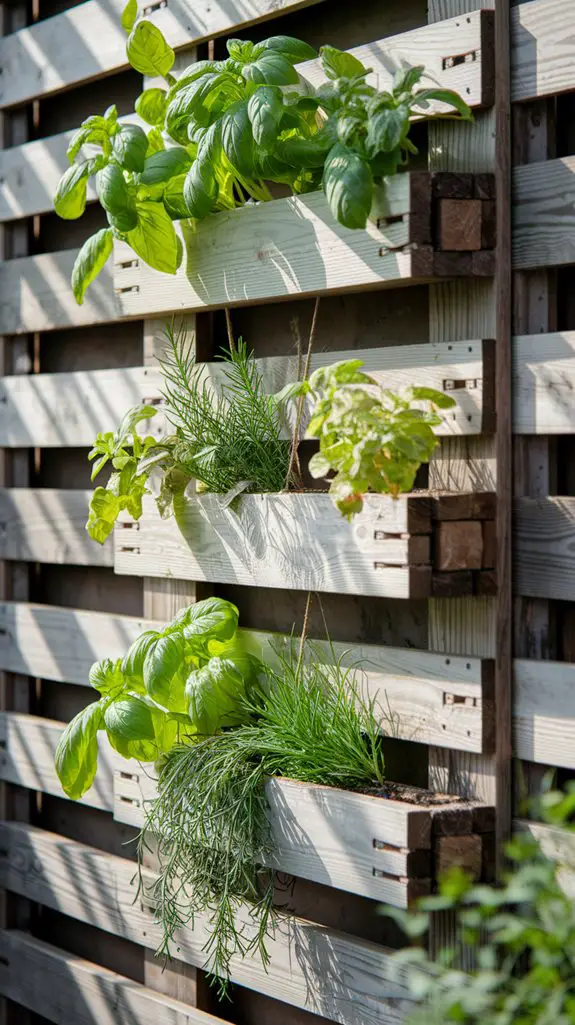
Wooden shipping pallets, often discarded after a single use, can transform into striking vertical herb gardens that maximize growing space while minimizing your environmental footprint.
Before starting your project, make sure you select heat-treated (HT) pallets rather than chemically-treated ones to avoid toxins leaching into your herbs. It's also essential to consider that filling raised garden beds properly can promote healthier plant growth.
Clean your pallet thoroughly, then attach landscape fabric to the back and bottom to create planting pockets.
Sand rough edges to prevent splinters during gardening tasks.
For the best herb growth, position your vertical garden where it receives at least six hours of sunlight daily.
Plant moisture-loving herbs like mint and basil in lower pockets, while drought-resistant varieties such as rosemary and thyme thrive in upper sections.
You'll appreciate how this space-saving solution turns waste into a functional, living wall of fresh herbs.
Creative Uses for Wine Bottles in Your Herb Garden
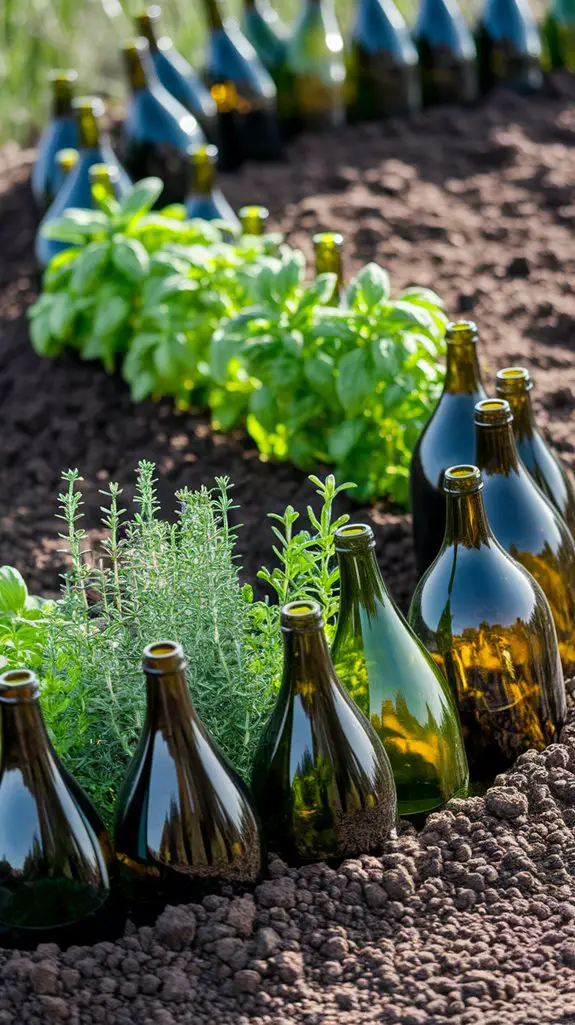
Wine bottles, once emptied of their flavorful contents, offer ingenious possibilities for herb garden enhancement rather than adding to landfill waste.
Turn them upside down to create eye-catching garden borders with their uniform height and striking colors. Carefully cut bottles can become self-watering planters—simply fill the inverted neck with water and place it in soil near your herbs.
For an elegant vertical display, secure bottles horizontally to a fence or wall using metal rings, then fill with soil and small herb varieties like thyme or oregano.
You can also create a drip irrigation system by drilling small holes in bottle caps and suspending them above your plants. The glass's thermal properties help regulate temperature, keeping herb roots protected during mild temperature fluctuations. Additionally, using recycled materials not only benefits your garden but also contributes to a more sustainable lifestyle.
Upcycled Tin Cans as Stylish Herb Pots

After enjoying your favorite canned goods, don't toss those empty tin cans in the recycling bin just yet—they're perfect candidates for transformation into stylish, eco-friendly herb containers.
Clean your cans thoroughly, removing labels and sharp edges. Drill drainage holes in the bottom to prevent root rot.
You can paint them with non-toxic, water-resistant paint or wrap them in twine, fabric scraps, or decorative paper for added charm. Additionally, using raised garden beds can enhance the growth of your herbs by providing better soil drainage and access to nutrients.
Group different-sized cans together for visual interest—soup cans work well for basil and cilantro, while larger bean cans accommodate mint or rosemary.
Secure them to a wall with brackets to create a space-saving vertical garden, or arrange them on a windowsill for convenient kitchen access to fresh herbs.
Second-Life Furniture as Herb Garden Stations
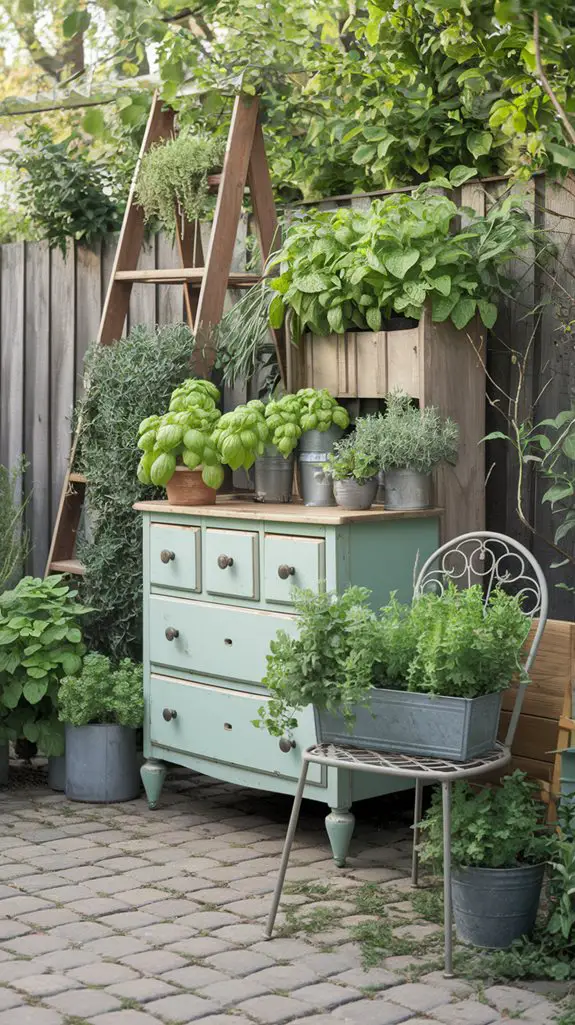
While tin cans offer compact herb-growing solutions, old furniture pieces can transform into substantial herb garden stations that serve both practical and aesthetic purposes.
An unused dresser becomes perfect when you remove drawers halfway, creating tiered planting levels for different herbs. Old wooden chairs gain new life when you convert seats into planting beds—ideal for trailing herbs like thyme or oregano.
Consider repurposing a discarded bookshelf by laying it horizontally to create distinct herb compartments, or convert an old wooden ladder into a vertical garden by hanging pots between rungs.
Even damaged tables work well—simply cut a hole in the center to accommodate a larger herb arrangement. Using recycled materials not only promotes sustainability but also adds a unique charm to your garden.
You'll reduce landfill waste while creating functional, conversation-starting herb stations that reflect your commitment to sustainability.
Plastic Bottle Herb Gardens: Sustainable and Practical
Plastic bottles that would otherwise end up in landfills can be transformed into ideal herb containers with minimal effort and cost. Simply cut bottles horizontally, creating self-watering planters when the top section is inverted into the base. Poke drainage holes and add soil to grow basil, mint, or chives.
You'll find these upcycled planters particularly useful for small spaces like windowsills or balconies. Their transparent nature allows you to monitor root development and soil moisture levels—ensuring best growing conditions without guesswork. Additionally, container vegetable gardening is an effective way to utilize limited space while growing fresh herbs at home.
For vertical gardens, connect several bottles using strong twine or wire, maximizing growing space while minimizing footprint.
Paint the exterior with non-toxic paint to protect plants from excessive sunlight and add aesthetic appeal to your sustainable herb collection.
Repurposing Old Footwear for Quirky Herb Displays
Beyond plastic bottles, your worn-out footwear offers another creative vessel for herb growing. Old boots, shoes, and even children's outgrown sneakers can transform into charming planters that add character to your garden while keeping these items out of landfills.
For successful footwear herb gardens:
- Choose footwear with adequate depth for root development—boots work especially well for deeper-rooted herbs like rosemary or sage.
- Drill drainage holes in the soles to prevent waterlogging and root rot.
- Add a layer of gravel before soil to improve drainage and extend the container's life.
This approach celebrates sustainable gardening by giving new purpose to items that would otherwise be discarded. Additionally, using eco-friendly practices in your gardening enhances the health of your local ecosystem.
You'll create conversation pieces that highlight your commitment to reducing waste while growing fresh herbs for your kitchen.
Broken Pottery and Dishware as Unique Herb Markers
Those chipped plates and broken mugs gathering dust in your cupboard deserve a second life as artistic herb markers for your garden. Break larger pieces into smaller shards, then use a permanent marker to write herb names clearly. Smooth any sharp edges with sandpaper for safety. Incorporating edible landscaping ideas can enhance the beauty and functionality of your garden.
| Material | Durability | Best For |
|---|---|---|
| Ceramic plates | High | Exposed areas |
| Coffee mugs | Very high | All-weather spots |
| Teacups | Medium | Sheltered beds |
| Wine glasses | Low | Indoor herbs |
| Porcelain | High | Decorative borders |
Your discarded dishware creates zero-waste markers that won't deteriorate like store-bought plastic alternatives. They'll withstand rain, sun, and soil contact while adding vintage charm to your herb garden. Plus, you'll save money while keeping perfectly usable materials out of landfills—a win for your wallet and the planet.
Creating Hanging Herb Gardens From Recycled Gutters
When looking for vertical gardening solutions, old rain gutters provide an ingenious way to grow herbs while maximizing limited space.
These lightweight channels can be mounted on fences, walls, or balcony railings, creating perfect growing beds for shallow-rooted herbs like thyme, oregano, and chives.
To create your hanging gutter garden, you'll need:
- Clean, discarded gutters cut to desired lengths (aluminum works best as it's lightweight and won't rust)
- End caps and mounting brackets (often salvageable from the same gutter system)
- Drainage holes drilled every 8-10 inches
This system not only repurposes materials headed for landfills but also creates efficient growing conditions. Seasonal herb gardens are ideal for homeowners looking to enjoy fresh flavors year-round.
The metal heats quickly, warming soil in spring, while the linear design makes watering and harvesting easy—simply walk along your aromatic gutter display.
Turning Old Ladders Into Tiered Herb Garden Displays
Wooden ladders that have outlived their climbing days can be transformed into striking tiered herb gardens that add vertical interest to any outdoor space while keeping your favorite culinary herbs within easy reach. Simply position your ladder against a wall or fence, or secure it to stand independently. Additionally, utilizing recycled materials can further enhance the sustainability of your garden project.
You'll need to create planting areas on each rung. Here's what works best:
| Container Type | Sustainability Level | Best Herbs |
|---|---|---|
| Mason jars | High – reused glass | Mint, chives, cilantro |
| Tin cans | High – upcycled | Rosemary, oregano, thyme |
| Wooden boxes | Medium – repurposed | Basil, dill, parsley |
| Burlap pouches | High – biodegradable | Sage, tarragon, marjoram |
Sand the ladder lightly before painting with non-toxic paint or natural sealant to protect it from the elements while maintaining its eco-friendly appeal.
Conclusion
By embracing recycled materials, you've transformed trash into treasure for your herb garden—where yesterday's forgotten items breathe new life into today's fragrant harvests. You're not just growing herbs; you're cultivating a sustainable lifestyle that nurtures both plants and planet. So continue this green journey, where every repurposed teapot and upcycled ladder becomes part of our collective effort to reduce waste while creating beautiful, productive spaces.

